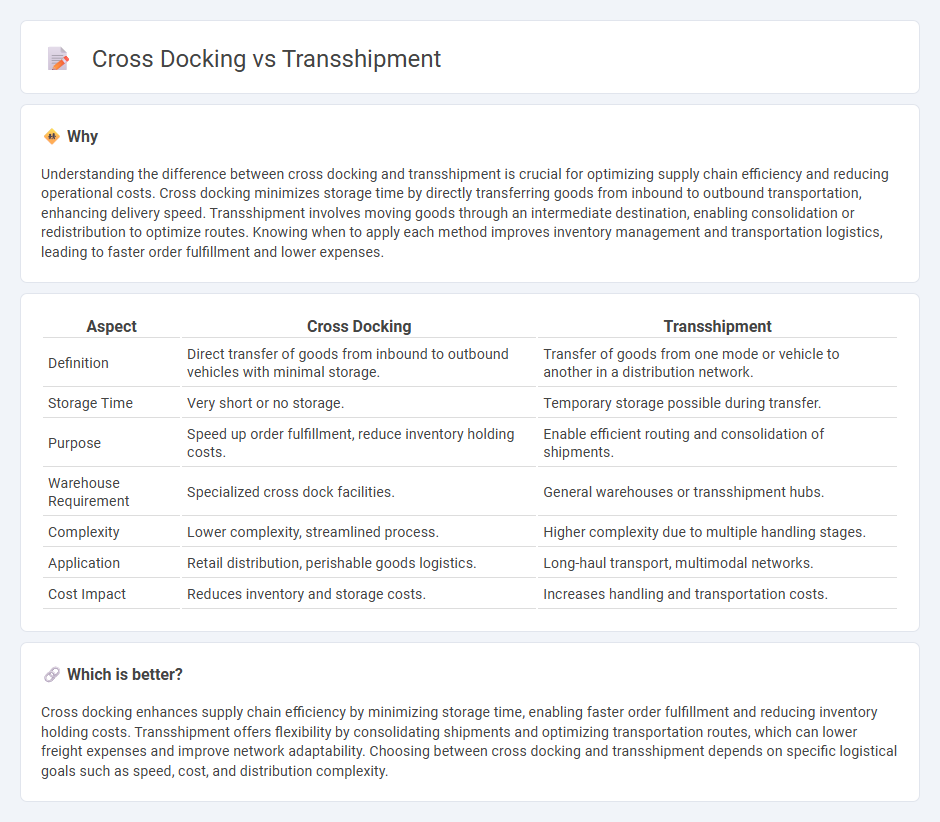
Cross docking streamlines supply chain operations by unloading products from inbound trucks and immediately loading them onto outbound trucks, minimizing storage time and reducing inventory costs. Transshipment involves transferring goods from one mode of transport to another at an intermediate point, facilitating efficient distribution across different transportation networks. Discover the key differences and benefits of cross docking and transshipment to optimize your logistics strategy.
Why it is important
Understanding the difference between cross docking and transshipment is crucial for optimizing supply chain efficiency and reducing operational costs. Cross docking minimizes storage time by directly transferring goods from inbound to outbound transportation, enhancing delivery speed. Transshipment involves moving goods through an intermediate destination, enabling consolidation or redistribution to optimize routes. Knowing when to apply each method improves inventory management and transportation logistics, leading to faster order fulfillment and lower expenses.
Comparison Table
| Aspect | Cross Docking | Transshipment |
|---|---|---|
| Definition | Direct transfer of goods from inbound to outbound vehicles with minimal storage. | Transfer of goods from one mode or vehicle to another in a distribution network. |
| Storage Time | Very short or no storage. | Temporary storage possible during transfer. |
| Purpose | Speed up order fulfillment, reduce inventory holding costs. | Enable efficient routing and consolidation of shipments. |
| Warehouse Requirement | Specialized cross dock facilities. | General warehouses or transshipment hubs. |
| Complexity | Lower complexity, streamlined process. | Higher complexity due to multiple handling stages. |
| Application | Retail distribution, perishable goods logistics. | Long-haul transport, multimodal networks. |
| Cost Impact | Reduces inventory and storage costs. | Increases handling and transportation costs. |
Which is better?
Cross docking enhances supply chain efficiency by minimizing storage time, enabling faster order fulfillment and reducing inventory holding costs. Transshipment offers flexibility by consolidating shipments and optimizing transportation routes, which can lower freight expenses and improve network adaptability. Choosing between cross docking and transshipment depends on specific logistical goals such as speed, cost, and distribution complexity.
Connection
Cross docking and transshipment are logistics processes focused on minimizing storage time and streamlining the movement of goods through supply chains. Cross docking involves unloading products from incoming trucks and loading them directly onto outbound trucks, enhancing efficiency in distribution centers. Transshipment refers to transferring goods from one mode of transport to another or between vehicles, often at intermediate points, facilitating flexible routing and improving delivery speed.
Key Terms
Intermediary Handling Point
Transshipment involves transferring goods at an intermediary handling point to reorder or consolidate shipments, often extending delivery time but optimizing route efficiency. Cross docking minimizes storage time by directly transferring products from inbound to outbound transportation at an intermediary handling point, enhancing speed and reducing inventory costs. Explore how these logistics strategies impact supply chain performance and efficiency.
Inventory Storage
Transshipment involves storing inventory temporarily at an intermediate facility before forwarding it to the final destination, allowing for consolidation and sorting of goods. Cross docking minimizes inventory storage by directly transferring products from inbound to outbound shipments, reducing handling time and storage costs. Explore detailed logistics strategies to optimize your supply chain efficiency.
Transfer Time
Transshipment involves temporarily storing goods at an intermediate location, which can increase transfer time due to handling and inventory processes. Cross docking minimizes transfer time by directly transferring products from inbound to outbound transportation, reducing or eliminating storage. Explore detailed comparisons to optimize logistics efficiency.
Source and External Links
Transshipment - Transshipment is the shipment of goods or containers to an intermediate destination, then onward to another final destination, often involving transferring cargo between vessels or transport modes during transit.
What is Transshipment? Complete guide [+lease containers] - Transshipment is a complex supply chain process whereby cargo containers are unloaded at an intermediate transshipment hub from one vessel and reloaded onto another to reach the final port; it is essential when there are no direct shipping routes between origin and destination.
Transshipment definition and meaning | FedEx South Korea - Transshipment involves moving goods between vehicles (e.g., ships, planes, trains) at specialized hubs due to indirect routes between export/import locations, typically lowering costs but increasing transit duration compared to direct shipment.
 dowidth.com
dowidth.com